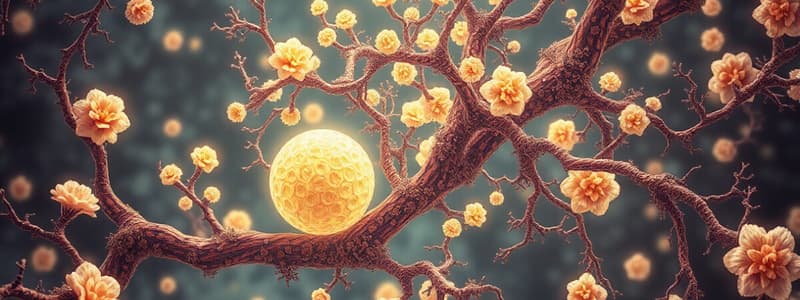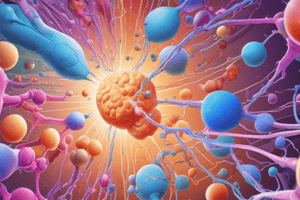Podcast
Questions and Answers
What are the primary functions of Ca2+ -ATPases in cells?
What are the primary functions of Ca2+ -ATPases in cells?
- Regulating neurotransmitter release
- Facilitating the storage of calcium in mitochondria
- Maintaining basal Ca2+ levels (correct)
- Converting ATP to ADP
Which of the following correctly describes the role of Na+/Ca2+ exchangers?
Which of the following correctly describes the role of Na+/Ca2+ exchangers?
- They help to remove calcium from cells against its gradient. (correct)
- They facilitate the entry of calcium during muscle contraction.
- They primarily store calcium in the nucleus.
- They are involved in the production of IP3.
What are the key signaling molecules produced by GPCRs that affect calcium release?
What are the key signaling molecules produced by GPCRs that affect calcium release?
- cAMP and cGMP
- Nitric oxide and cyclic AMP
- Calmodulin and CaM kinase
- IP3 and DAG (correct)
How do STIM and Orai receptors contribute to calcium homeostasis?
How do STIM and Orai receptors contribute to calcium homeostasis?
Which process is NOT influenced by intracellular calcium signaling?
Which process is NOT influenced by intracellular calcium signaling?
What cellular process is directly affected by the level of intracellular calcium?
What cellular process is directly affected by the level of intracellular calcium?
Which of the following is NOT a role of calcium in cellular functions?
Which of the following is NOT a role of calcium in cellular functions?
Which scientists provided early evidence for the role of calcium in neurotransmission?
Which scientists provided early evidence for the role of calcium in neurotransmission?
How many Ca2+ ions are moved out of the cell for each ATP hydrolyzed by PMCA?
How many Ca2+ ions are moved out of the cell for each ATP hydrolyzed by PMCA?
Which protein enhances the activity of PMCA through binding?
Which protein enhances the activity of PMCA through binding?
What is the function of SERCA in muscle cells?
What is the function of SERCA in muscle cells?
Which of the following describes the states of SERCA?
Which of the following describes the states of SERCA?
Which gene encodes the NCX protein?
Which gene encodes the NCX protein?
Which subfamily of voltage-gated Ca2+ channels includes L-type channels?
Which subfamily of voltage-gated Ca2+ channels includes L-type channels?
The calcium release from intracellular stores is primarily mediated by which receptor?
The calcium release from intracellular stores is primarily mediated by which receptor?
Which of the following statements regarding NCX isoforms is correct?
Which of the following statements regarding NCX isoforms is correct?
What is the typical free cytoplasmic calcium concentration ([Ca2+i]) in cells?
What is the typical free cytoplasmic calcium concentration ([Ca2+i]) in cells?
Which protein is known for its calcium-binding ability and contains the EF-hand motif?
Which protein is known for its calcium-binding ability and contains the EF-hand motif?
What type of calcium transport system transfers calcium across membranes after muscle contraction?
What type of calcium transport system transfers calcium across membranes after muscle contraction?
Which of the following statements about PMCA and SERCA is true?
Which of the following statements about PMCA and SERCA is true?
Which of the following serves as a specialized channel for calcium entry into cells?
Which of the following serves as a specialized channel for calcium entry into cells?
What is the function of calsquestrin in muscle cells?
What is the function of calsquestrin in muscle cells?
Which of the following mechanisms is NOT involved in moving calcium into cells?
Which of the following mechanisms is NOT involved in moving calcium into cells?
How do calcium buffering proteins help in cellular functions?
How do calcium buffering proteins help in cellular functions?
What structural form do IP3 receptors (IP3R) take?
What structural form do IP3 receptors (IP3R) take?
What role do STIM1 proteins serve during store-operated calcium entry (SOCE)?
What role do STIM1 proteins serve during store-operated calcium entry (SOCE)?
Which proteins are involved in store-operated calcium entry?
Which proteins are involved in store-operated calcium entry?
What happens to STIM1 proteins upon calcium store-depletion?
What happens to STIM1 proteins upon calcium store-depletion?
What is the main consequence of mutations in STIM1?
What is the main consequence of mutations in STIM1?
Where is most intracellular calcium primarily found?
Where is most intracellular calcium primarily found?
Which channel type is NOT involved in calcium transport?
Which channel type is NOT involved in calcium transport?
What is the function of Ca2+ ATPases?
What is the function of Ca2+ ATPases?
Flashcards are hidden until you start studying
Study Notes
Calcium Homeostasis
- Calcium is essential for a variety of cellular functions, including neurotransmitter and hormone release, muscle contraction, cell excitability, and protein synthesis.
- Calcium homeostasis involves precise regulation of calcium concentrations both inside and outside of cells.
- Extracellular calcium concentrations are around 1mM.
- Intracellular calcium concentrations are around 0.1μM.
- Calcium-binding proteins like calmodulin, S100 proteins, and calcineurin bind to calcium directly.
- Calcium-buffering proteins like calnexin and calsquestrin work together to store calcium within intracellular organelles.
Calcium Transport
- Points of Entry for Calcium
- Ca2+-ATPases:
- PMCA (Plasma Membrane Ca2+ ATPase) moves calcium outside the cell, using ATP.
- SERCA (Sarcoplasmic Reticulum Ca2+ ATPase) moves calcium into the sarcoplasmic reticulum, using ATP..
- Voltage-gated Ca2+ Channels
- L-type Ca2+ channels play a key role in calcium influx.
- Na+/Ca2+ exchanger (NCX):
- NCX1, NCX2, and NCX3 exchange calcium ions for sodium ions.
- Permeability Transition Pore
- Influx Mechanisms: Various pumps, exchangers, and channels are involved in moving calcium into and out of cells, including different organelles.
- Ca2+-ATPases:
- Other Important Calcium Signaling Molecules:
- IP3 (inositol 1,4, 5-trisphosphate): This molecule activates IP3 receptors in the endoplasmic reticulum (ER), leading to calcium release from ER stores.
- IP3 receptors are tetramers with four transmembrane domains.
- STIM1: This protein senses changes in ER luminal calcium levels.
- Orai1: This protein interacts with STIM1, enabling calcium influx from the extracellular space.
- IP3 (inositol 1,4, 5-trisphosphate): This molecule activates IP3 receptors in the endoplasmic reticulum (ER), leading to calcium release from ER stores.
- Store-Operated Calcium Entry (SOCE): A process by which depletion of calcium from intracellular stores leads to calcium influx from the extracellular space.
- SOCE is essential for maintaining continuous calcium signaling in cells.
- Mutations in STIM1 can lead to increased SOCE.
Studying That Suits You
Use AI to generate personalized quizzes and flashcards to suit your learning preferences.




